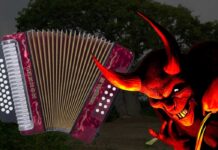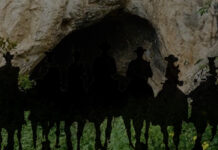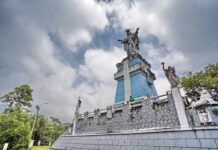The Myth of Mother Bachué It is one of the most important myths of the people's worldview Muisca (chibchas), this myth tells us how Bachué together with her husband gave rise to humanity when they emerged from the Iguaque lagoon, which is located in the municipality of Chiquiza in it Boyacá department, Colombia.
The myth relates that, from the mythical lagoon of Iguaque, one day a beautiful and slender woman emerged, who had long black hair, this woman was Bachué, by the hand of Bachue A child of around 3 years old came.
(Read Also: Myth of the Origin of the Sun and the Moon (Arhuacos))
Bachué and the child left the waters of the Iguaque lagoon, descended from the mountain and settled in the savanna where she built a house in which they lived until the child was old enough to marry, which constituted the first Muisca marriage, after this event the child fertilized Bachué, since their mission was to populate the world with their children, in each birth Bachué had four, five and even more children, Bachué and her husband moved throughout the Chibcha empire founding towns and leaving their children in all of them.
During that time Bachué taught the Muisca people the rules to live in peace among themselves and with other peoples, he taught them how to worship the gods, to live in harmony with what surrounded them and many other things, the people began to call her Furachogua which means “Good Woman”, since in the Chibcha language Fura is “Woman” and Chogua is “Good”.
When both were already very old and seeing that their work was accomplished, they decided to leave for the Iguaque lagoon accompanied by all the Muisca people who mourned their early departure. Once they met in the place, both Bachué and her husband were transformed into two enormous culebras (snakes) and immersed themselves in the lagoon.
(Read Also: Kaliawirinae, the myth of the food tree (Sikuani))
Not before exhorting her people to follow the precepts and teachings that she had given them, it is said that from time to time you can see the great snake that peeks its eyes into the water to remind them that it is always watching and taking care of its people. .
Origin of the Bachué myth
The Bachué myth either Batchue It has its origin in the Muisca culture (Chibchas), this indigenous people inhabited what today includes the south of the department of Santander and the Cundiboyacense plateau. For the Muisca people Bachué is the primal mother of all the Muisca people, for this reason they call her “Mother Bachué”.
Thanks to her work as a parent and for all the teachings that she instilled in them, Bachué is considered by the Chibcha people as one of their deities or gods. She was considered the goddess of fertility, protector of crops and primal mother of humanity.
(Read Also: Iraca and Ramiriquí: Myth of the origin of humans, the sun and the moon (Chibchas))
In the Muisca worldview, women are born with wisdom, which is why Bachué is represented as an adult and wise woman, while for them men are born immature compared to women, which is why they are represented as children, this is one of the most possible theories by which the myth of Bachué relates the appearance of the first woman and the first man, representing them as an adult woman and a child; It is also worth noting that the indigenous Muisca communities had a strong sense of matriarchy, this is denoted by the fact that in the story the name of the woman is mentioned but not that of the child, in some stories the name of Qhuzha, Qhu (Seed) zha (night) meaning little man, but this name is a general representation of the birth of men.
One of the oldest documented references to this myth is the chronicler's chronicle. Fray Pedro Simón which he captured in his work “Historical News” This myth was published in 1626, accompanied by a story that mentioned the strategies that the conquerors used to try to destroy or steal symbols they considered inappropriate and which were mostly made of gold.
Other Versions of the Bachué myth
As is the case with a large part of the legends and myths of the country, there are several versions around the myth of Bachué, this is due more than all to the fact that being an oral story that is transmitted from generation to generation, some elements of the story are left behind. losing or altering.
(Read Also: Bochica: The myth of the civilizing master god of the Muiscas)
In some versions it is indicated that the child who comes with Bachué is his son, in others there is no record of this fact, also in some it is mentioned that at the time of his departure from Lake Iguaque a large wave arose that he swallowed them, other stories mention that they decided to leave without telling anyone, some versions also indicate that there were already humans at the time of their arrival and that Bachué's role was more than anything to increase the population.
What does Bachué look like?
Bachué is described as a dark, slender woman, with long black hair and very beautiful. When he decides to leave again for the Iguaque lagoon, he transforms into a large snake that usually peeks out into the waters to watch over and protect his people.
Bachué in popular culture (Tributes and representation)
Bachué is a figure that has become an essential part not only of culture muisca if not also of all Colombians, hence the fact that over time his figure has permeated various cultural and social environments of the territory.
(Also read: Francisco the man: The legend and the minstrel)
In addition to the different tunjos and representations that the Muisca people have created around the figure of Bachué, there are other representations more typical of modern art, among which you can find the sculpture to Bachué in Medellín, authored by the sculptor José Horacio Betancur, the sculpture “La Bachué, generating goddess of the Chibcha Indians” of Romulo Rozo created in 1925 which became a piece of great value within Colombian art and inspired artistic movements within the country. There are also enterprises such as Hotel Bachue de Girardot, he Hotel Bachue in Bucaramanga, the Bachue jewelry from Medellín, among others that pay tribute to their cultural figure by integrating his name into their ventures, there are also neighborhoods that bear the name of Bachué, musical and artistic groups that also pay tribute to him.
Did you like this article? Leave your opinion in the comments and share this story with your friends and acquaintances so they can discover our unique stories.





